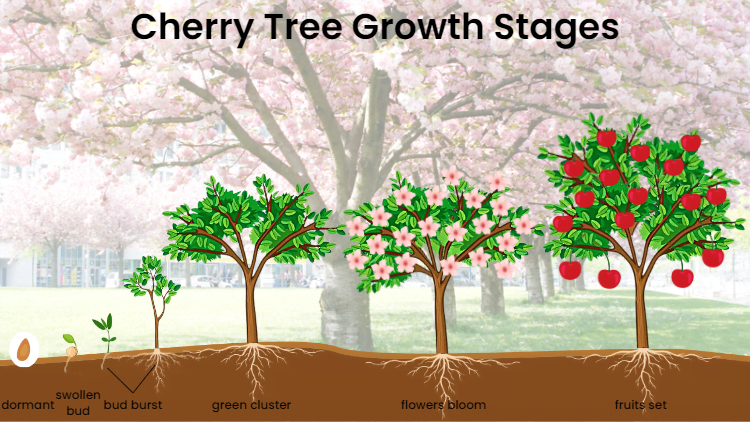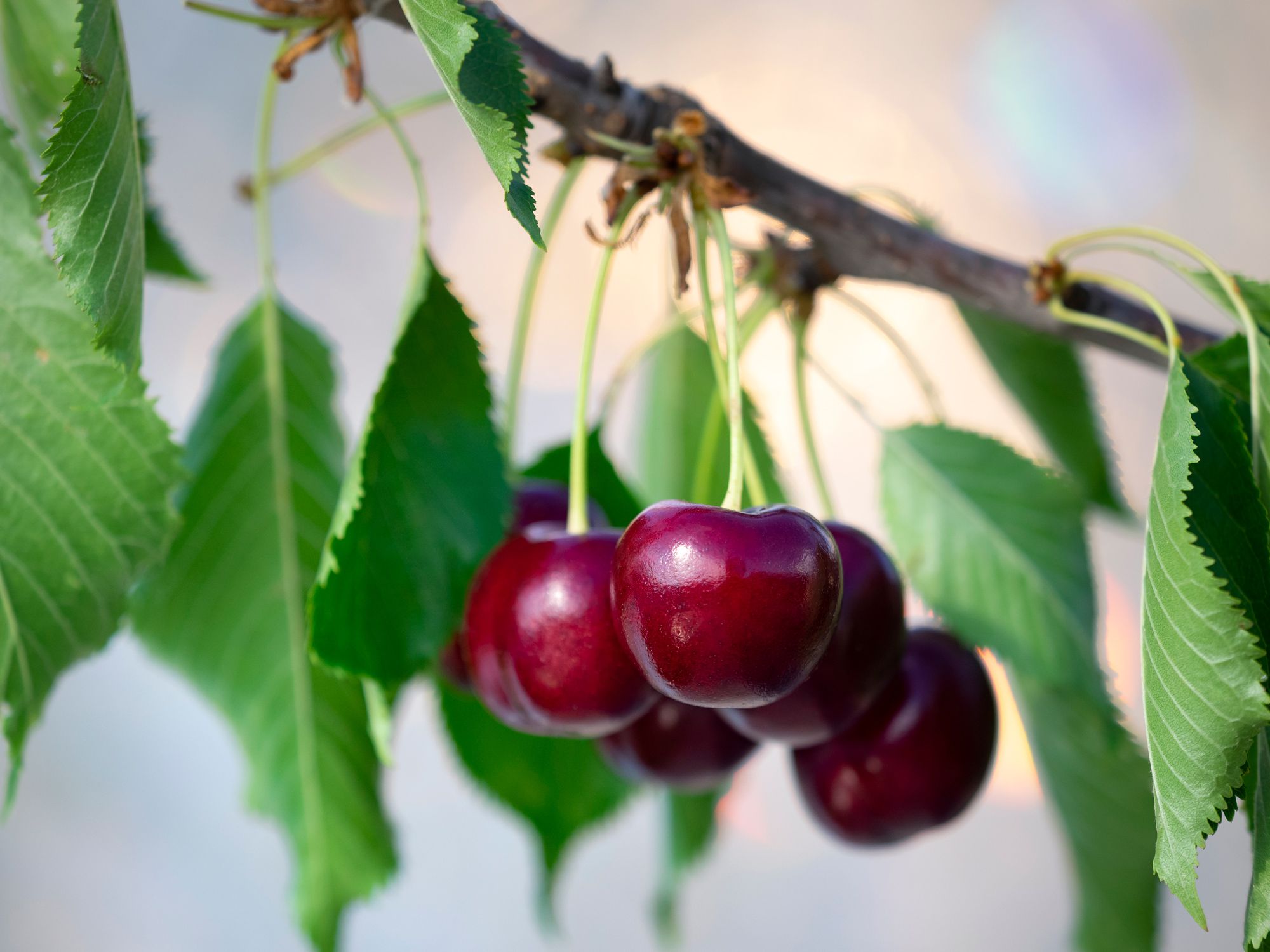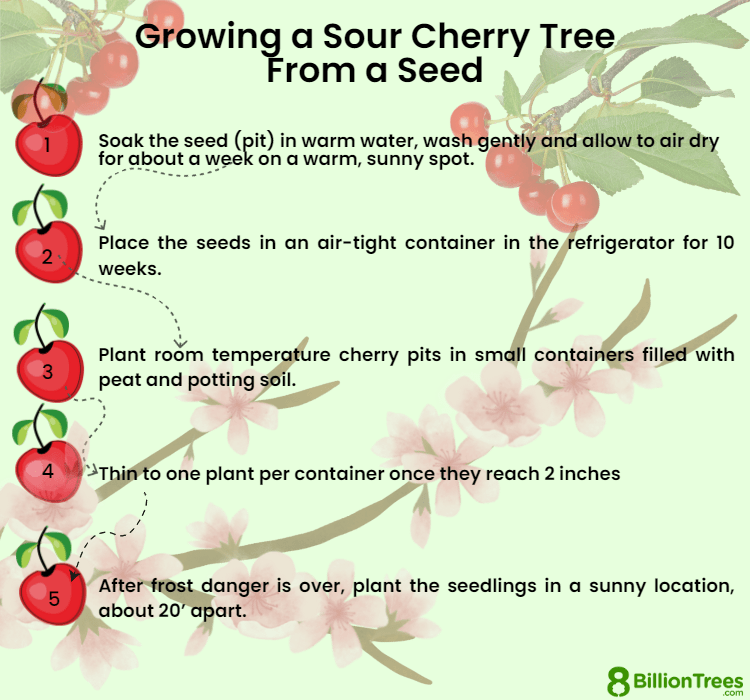Cherries, known for their vibrant red color and mouthwatering taste, are a beloved fruit enjoyed by many. But have you ever wondered just how long it takes for these luscious cherries to grow? The answer to this question lies in a delicate process that involves precise timing, ideal growing conditions, and a certain amount of patience. In this article, you will discover the key factors that contribute to the growth of cherries and gain a deeper understanding of the time it takes for this delicious fruit to reach its ripe, plump state.

Factors Affecting Cherry Growth
Type of Cherry Tree
The type of cherry tree plays a crucial role in the growth and development of cherries. There are numerous varieties of cherry trees, each with distinct characteristics and growth requirements. Some varieties, such as sweet cherries, require a longer growing season, while others, like sour cherries, are better suited for colder climates. It is important to select the right variety of cherry tree based on your geographical location and climate conditions to ensure optimal growth.
Climatic Conditions
Climatic conditions have a significant impact on cherry tree growth. Cherries thrive in temperate climates, with cool winters and mild summers. An ideal temperature range for cherry growth is between 45°F and 85°F. Extreme weather events, such as frost or heatwaves, can adversely affect cherry trees, leading to reduced yields or even the death of the tree. It is important to consider the climate of your region and choose cherry tree varieties that are well-adapted to those conditions.
Soil Conditions
The quality and composition of the soil are crucial factors in cherry growth. Cherry trees prefer well-drained soils with a pH level between 6.0 and 7.5. The soil should be rich in organic matter and have good water retention capacity. Proper soil preparation, including regular testing and amendments, can significantly contribute to healthy and vigorous cherry tree growth. Additionally, it is important to ensure that the soil is free from contaminants or toxins that could harm the tree.
Pruning and Training
Pruning and training are essential practices in promoting optimal cherry tree growth. Pruning helps maintain tree shape, improve airflow, and remove diseased or damaged branches. It also stimulates new growth and enhances fruit production. Training involves directing the growth of the tree through selective pruning and the use of supports or trellises. Proper pruning and training techniques not only promote healthy growth but also improve the overall structure and longevity of the cherry tree.
Pest Control Measures
Pests and diseases can severely impact cherry tree growth and reduce fruit yield. Common pests that affect cherries include aphids, mites, fruit flies, and birds. It is important to implement pest control measures, including regular monitoring, timely treatment, and the use of organic or chemical insecticides, to prevent infestations and protect the cherry crop. Additionally, proper sanitation practices and maintaining overall tree health are crucial in preventing the onset of diseases and improving cherry tree growth.
Cherry Tree Growth Stages
Budding Stage
The first stage of cherry tree growth is the budding stage. During this stage, small buds begin to appear on the branches of the tree. These buds contain the potential for future growth, including leaves, flowers, and eventually fruit. The timing of the budding stage varies depending on the variety of cherry tree and the climatic conditions. Generally, cherry trees start budding in early spring, when the temperature begins to rise and days become longer.
Blossoming Stage
The blossoming stage is one of the most visually stunning periods in the growth cycle of cherry trees. It is during this stage that the buds on the tree open up, revealing beautiful flowers in shades of white, pink, or red. The blossoming stage is crucial for pollination and fruit development. Bees and other pollinators are attracted to the flowers, transferring pollen from one flower to another. The timing and duration of the blossoming stage vary depending on the cherry tree variety and environmental factors such as temperature and sunlight.
Fruit Formation Stage
After successful pollination, the cherry tree enters the fruit formation stage. During this stage, the flowers are fertilized, and the ovaries develop into small, green fruit. This stage is a critical time for the cherry tree, as proper care and maintenance are essential to ensure healthy fruit development. Factors such as adequate sunlight, water, and nutrient availability play a significant role in determining the quality and quantity of fruit produced.
Maturation Stage
The final stage of cherry tree growth is the maturation stage. As the fruit continues to develop, it undergoes a gradual change in color, texture, and flavor. The time it takes for cherries to reach full maturity varies depending on the variety and growing conditions. Generally, cherries are ready for harvest approximately 70 to 90 days after the blossoming stage. During the maturation stage, it is important to carefully monitor the fruit and harvest at the optimal time to ensure peak flavor and sweetness.

Different Types of Cherries and Their Growing Seasons
Sweet Cherries
Sweet cherries, also known as dessert cherries, are the most commonly consumed type of cherries. They are characterized by their juicy flesh, rich flavor, and vibrant colors. Some popular varieties of sweet cherries include Bing, Rainier, and Brooks. The growing season for sweet cherries typically starts in late spring, with the fruit becoming ripe and ready for harvest in early to mid-summer, depending on the region.
Sour Cherries
Sour cherries, also known as tart cherries, have a distinct tart or sour flavor that is often used in cooking and baking. They are smaller in size compared to sweet cherries and have a vibrant red color. Popular varieties of sour cherries include Montmorency and Morello. The growing season for sour cherries is slightly shorter than that of sweet cherries, with harvest usually occurring in late spring to early summer.
Dwarf Cherry Trees
Dwarf cherry trees are smaller in size and are often preferred by home gardeners with limited space. They are bred to have a compact growth habit while still producing a reasonable amount of fruit. Dwarf cherry trees can be of both sweet and sour varieties, allowing homeowners to enjoy their favorite cherries in a smaller, more manageable form. The growing season for dwarf cherry trees is generally the same as their full-sized counterparts.
Specific Cherry Varieties and Their Growth Timeline
Bing Cherries
Bing cherries are one of the most popular sweet cherry varieties. They are characterized by their dark red, almost purple, skin and sweet, juicy flesh. Bing cherries typically take around 70 to 90 days to reach full maturity after the blossoming stage. The exact timing may vary depending on factors such as climatic conditions and growing techniques. Bing cherries are often ready for harvest in late spring to early summer.
Rainier Cherries
Rainier cherries are a unique variety known for their golden-yellow skin with a bright red blush. They have a distinctive sweet and slightly acidic flavor that is highly sought after. Rainier cherries generally take around 75 to 90 days to fully mature after the blossoming stage. They are typically harvested in late spring or early summer, depending on the growing region.
Montmorency Cherries
Montmorency cherries are a popular sour cherry variety, cherished for their tart and tangy flavor. They are often used in pies, jams, and other culinary creations. Montmorency cherries have a relatively shorter growth timeline compared to sweet cherries, typically reaching maturity around 60 to 80 days after the blossoming stage. The harvest season for Montmorency cherries typically falls in late spring to early summer.

Factors That Can Impact Cherry Growth Time
Pest and Disease Infestations
Pests and diseases can significantly impact the growth time of cherry trees. Infestations of insects, such as aphids or fruit flies, can damage the fruit or prevent it from developing properly. Diseases like cherry leaf spot or brown rot can also affect the growth and quality of cherries. Timely detection and proper pest and disease control measures are essential to minimize their negative impact on cherry growth time.
Extreme Weather Events
Extreme weather events, such as frost, heatwaves, or excessive rainfall, can disrupt the growth cycle of cherry trees. Frost during the budding or blossoming stages can damage or kill young buds or flowers, reducing the fruit yield. Likewise, prolonged periods of heat or drought can lead to water stress and impact fruit formation and maturation. Protecting cherry trees from extreme weather conditions and providing appropriate support, such as irrigation or frost protection methods, can help mitigate the negative impact on growth time.
Poor Soil Quality
The quality of the soil directly affects the growth and development of cherry trees. Soil deficiencies in essential nutrients, improper pH levels, or excessive compactness can hinder root development and nutrient absorption. This, in turn, can slow down overall tree growth and delay the time it takes for cherries to mature. Regular soil testing, appropriate amendments, and proper soil management practices are necessary to ensure optimal soil conditions for cherry tree growth.
Inadequate Pruning and Training
Improper pruning and training practices can have a detrimental effect on cherry tree growth time. Failure to prune can lead to overcrowding, reduced airflow, and increased susceptibility to diseases. On the other hand, excessive pruning or incorrect techniques can weaken the tree and delay its growth. It is important to adhere to proper pruning and training guidelines specific to cherry trees, promoting healthy growth and ensuring the desired growth timeline.
Cherry Tree Growth Rates in Various Climates
Temperate Climates
Cherry trees thrive in temperate climates, where they receive a balanced combination of cool winters and mild summers. In such climates, cherry trees typically experience optimal growth rates, with healthy blossoms and fruit development. The consistent temperature range and suitable climatic conditions contribute to a predictable and reliable growth timeline for cherries.
Subtropical Climates
In subtropical climates, cherry tree growth rates can be somewhat challenging. The absence of cold winter dormancy can disrupt the natural growth cycle of cherry trees, potentially affecting fruit production or yield. However, with careful selection of adapted varieties and proper management practices, it is possible to successfully grow cherries in subtropical regions, albeit with slightly different growth rates and harvesting times.
Mediterranean Climates
Mediterranean climates are characterized by hot, dry summers and mild, rainy winters. These conditions can pose certain challenges for cherry tree growth, as the trees are susceptible to water stress and heat damage. Adequate irrigation, shade management, and careful selection of cherry tree varieties suited for Mediterranean climates are essential to achieve optimal growth rates and fruit production.

Tips for Accelerating Cherry Growth
Choosing the Right Variety
Selecting cherry tree varieties that are well-suited to your climate and growing conditions is essential for accelerating cherry growth. Opt for varieties known for their adaptability, disease resistance, and optimal growth rates in your specific geographical region. Consulting with local horticultural experts or experienced growers can help you make informed decisions and choose the best cherry varieties for accelerated growth.
Providing Optimal Growing Conditions
Creating and maintaining optimal growing conditions for cherry trees can significantly accelerate their growth. Ensure that the trees receive sufficient sunlight, as cherries require full sun exposure for optimal growth and fruit production. Adequate irrigation, regular fertilization, and proper mulching help provide the necessary nutrients and moisture for accelerated growth. Additionally, optimizing soil conditions through regular testing and appropriate amendments promotes vigorous root development and faster growth.
Proper Pruning and Training
Implementing effective pruning and training practices can help accelerate cherry tree growth. Pruning allows for the removal of dead or diseased branches, enhancing the overall health and vigor of the tree. Training methods such as espalier or trellising can direct the growth of the tree, maximizing sunlight exposure and improving air circulation. Regular pruning and training help maintain an optimal tree structure, boost growth, and promote earlier fruit production.
Implementing Pest Control Measures
Pests can significantly hinder cherry tree growth and delay fruit production. Implementing proactive pest control measures, such as regular monitoring, early detection, and appropriate treatment, can help prevent infestations and accelerate growth. Integrated pest management practices, including the use of biological controls or organic insecticides, can effectively manage pests while minimizing negative impacts on the environment.
Common Mistakes That Slow Down Cherry Growth
Incorrect Pruning Techniques
Pruning cherry trees incorrectly can hinder their growth and delay fruit production. Improper cuts or excessive pruning can weaken the tree or cause unnecessary stress. Using sharp, clean pruning tools and following proper pruning guidelines specific to cherry trees are essential to ensure healthy growth and optimize fruit production.
Improper Watering Practices
Watering cherry trees incorrectly can slow down their growth and negatively impact fruit development. Overwatering may lead to root rot or waterlogged soil, while underwatering can result in water stress and stunted growth. It is important to provide consistent and adequate water to cherry trees, taking into account factors such as soil moisture levels, weather conditions, and the stage of growth.
Ignoring Pest Control
Neglecting pest control measures can lead to pest infestations that damage the tree and slow down its growth. Regular monitoring for signs of pests, implementing preventive measures, and timely treatment are crucial to maintaining healthy cherry trees and promoting accelerated growth. Ignoring pest control can result in weakened trees, reduced fruit quality, and prolonged growth timelines.
Neglecting Soil Health
Soil health is vital for cherry tree growth and overall tree vigor. Neglecting soil health by ignoring regular soil testing, inadequate nutrient amendments, or poor soil management practices can limit the growth potential of cherry trees. Maintaining optimal soil conditions, including proper pH levels, nutrient balance, and organic matter content, is essential for promoting accelerated growth and achieving desired fruit production timelines.

Harvesting Time for Different Cherry Varieties
Sweet Cherries
Harvesting times for sweet cherries vary depending on the variety and growing conditions. Typically, sweet cherries are ready for harvest approximately 70 to 90 days after the blossoming stage. The exact timing may also depend on factors such as climatic conditions and specific regional variations. Sweet cherries are harvested when they are fully ripe, characterized by their vibrant color, firmness, and high sugar content.
Sour Cherries
Sour cherries typically mature earlier than sweet cherries and are ready for harvest in late spring to early summer. The harvesting time for sour cherries usually falls around 60 to 80 days after the blossoming stage. It is crucial to harvest sour cherries at the appropriate time, ensuring they are fully ripe and have developed their characteristic tart flavor.
Dwarf Cherries
Dwarf cherry trees generally have a similar harvesting timeline as their full-sized counterparts. The exact timing for harvesting dwarf cherries depends on the variety and growing conditions. As with other cherry tree varieties, it is important to monitor the fruit’s growth and harvest when it is fully mature, resulting in the desired flavor and sweetness.
Conclusion
Growing cherries requires careful consideration of various factors that can influence tree growth and fruit production. Factors such as the type of cherry tree, climatic and soil conditions, pruning and training practices, and pest control measures all play significant roles in determining the growth timeline of cherry trees. Understanding the growth stages of cherry trees, different types of cherries, as well as common mistakes and tips for accelerating growth, will help ensure successful cherry cultivation. By providing optimal growing conditions, implementing proper management practices, and timely harvesting, you can enjoy bountiful harvests of delicious cherries year after year.



